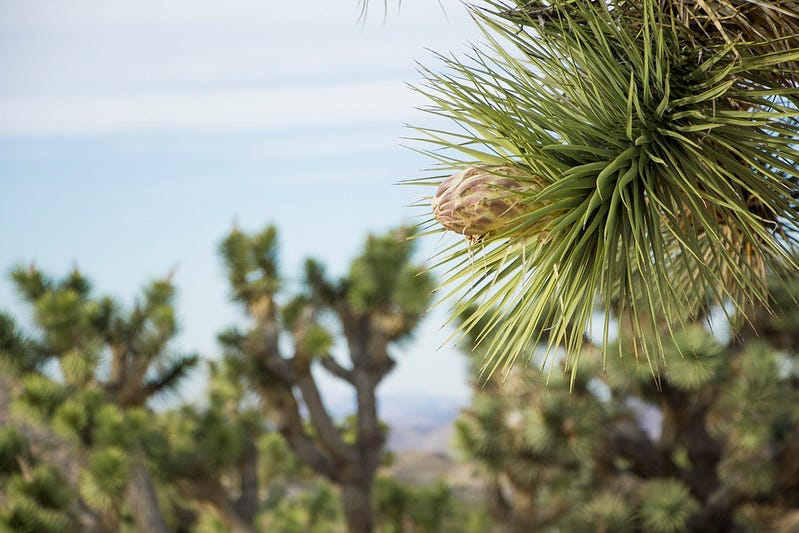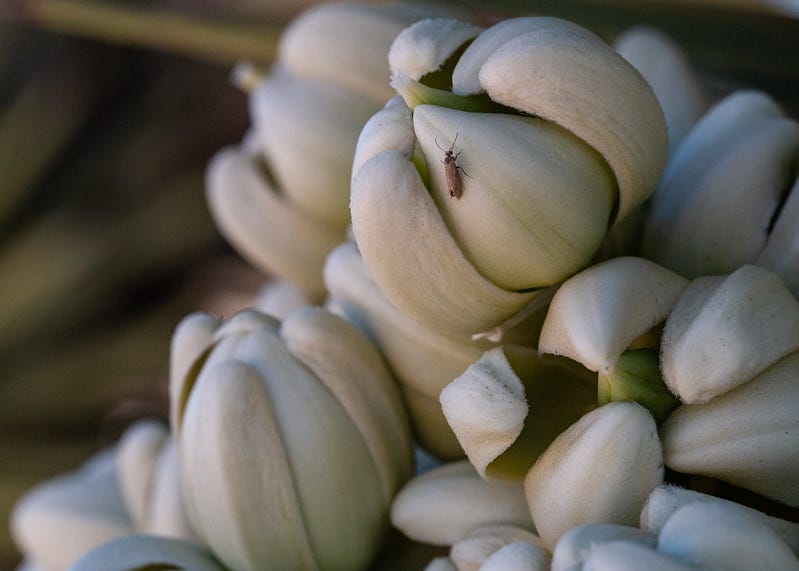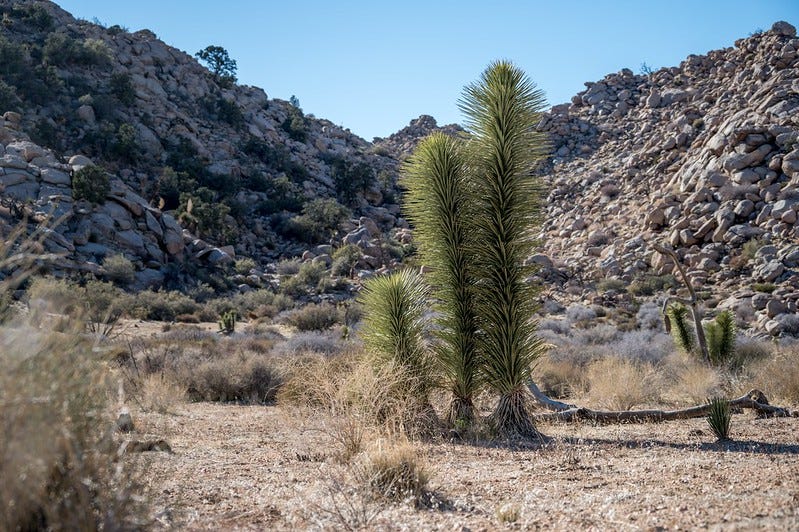As spring settles in, we have cause for celebration. Our Joshua trees are blowing up with flowers.
Yucca brevifolia, commonly know as the Western Joshua tree, has been around since the Pleistocene. Having made it for this long in spite of shrinking habitat and the extinction of its primeval seed disperser (a prehistoric nine-foot long ground sloth), these iconic trees haven’t endured by being dummies. One strategy in their survival tool box is masting,1 whereby a high percentage of the population synchronizes blooming every five years or so. While it’s a matter for scientists, not essayists, to decide if 2025 will be proclaimed an official mast year, these episodic displays invite a ramble.

The whys and whens of such bumper crops remain theoretical but the accepted thinking is simple. As a keystone2 species, Joshua trees are a mother lode within their ecosystem, and they support a wide array of other living things. By flooding the wildlife market with more flower and seed than can be consumed, fruits are left behind to ripen and spill to the ground. Rodents (now the primary seed disperser of Y. brevifolia) carry off as much overflow as they can grab, caching uneaten stores of the little black nuggets in their hidey-holes. Not all of the stash is retrieved and some germinates. In a cycle that propagates new Jts, the hoarders are also laying groundwork for their offspring to enjoy even bigger hauls down the road.
Nature just makes sense. Flower spikes are white, fragrant, and held high in order to be discoverable in darkness by Y. brev’s only pollinator, a nocturnal moth. Crafty bloom presentation is a survival imperative—no pollinator, no viable seed. Floral lures aside, the trees have a second way to clinch the deal with their moths. The seeds are the exclusive food of the larva, and masting produces the extra needed to reward their pollinator for fertility. Giving and taking, with loopholes: if too many moth eggs are laid in a flower, the developing seed can abort, preventing an imbalanced larval population from overwhelming the tree’s reproductive goals.
To split hairs further, only one moth has the anatomy to pollinate Y. brevifolia, while Y. jaegeriana (the Eastern Joshua tree) has a singular relationship with a different moth. In such obligate mutualism,3 neither moth nor plant can continue to exist without the specific other.
Glimpsing moths can be elusive but the visual differences between the two species of Joshua trees are apparent. Our westerners trend taller with longer leaves, while their eastern kin sport a shorter, multi-trunk form with stubbier rosette heads. As temperatures rise, some researchers postulate that Y. brev will evolve toward Y. jaeg’s compact form…after all, it takes a lot more energy to draw water and nourishment up a taller trunk, and elevating foliage above the muzzle of a giant sloth is no longer relevant.
Both Joshua trees are capable of vegetative reproduction4 by sending out horizontal root stalks, which produce sucker plants as a fail-safe to seeding. These can sprout several feet away from the original tree and are often misconstrued as new individuals, tempting well-meaning humans to relocate them as garden freebies. However, unlike dividing agaves or grasses, transplanting Joshua tree offsets is a doomed affair as the clones rely on the mature root system of the parent plant for sustenance. They do play a role in harvesting additional sunlight energy and mainlining it to the larger complex for photosynthetic processing, similar to adding more panels to your solar infrastructure.
But generally speaking, clonal reproduction has less status in nature’s hierarchy than seed reproduction: clones are an exact genetic duplicate of the parent whereas every seed is a unique individual with the potential of having some one-off trait that holds a key to resilience in times of changing environmental pressures. Seeds also carry latent traits, either useful in a past era or anomalies that have yet to be discarded, ready to be triggered when conditions shift. Deviation followed by natural selection, the far-sighted equation for hardiness. Before the Anthropocene, organisms had all the generations in the world to contemplate such things.
Because nature’s basic MO means probing for improvement through experimentation, it’s not surprising to learn that a few Y. brevifolia x Y. jaegerina hybrids manifested along the way. Evolutionarily speaking these outliers don’t show signs of having particularly useful adaptations as their known population has failed to expand past a region shared with military testing and the infamous Area 51. They do inspire thoughts about the dexterity of a few local moths, but given its UFO pedigree, novel pollinator gymnastics would hardly be the freakiest thing to ever happen in Tikaboo Valley, Nevada. Let’s leave it there and return to masting.
Although predator satiation5 is just a leading hypothesis for Joshua tree masts, the premise dovetails seamlessly with fact. Seed production costs plants dearly in energy expenditure. Annual blooming is a risky gamble for a species that must sustain a large body and also hold onto substantial reserves as a hedge against years of drought. By holding back and then communally blasting flowers, the resources spent on seeding become a smarter, to-scale investment, wherein each individual stands a better shot at both passing on its unique adaptations and also contributing to the long term survival of the species by out-competing herbivory.
That’s what’s so amazing about plants, their total dedication to forward thinking strategies for species persistence. Well, not just that. Only plants can perform energy conversion by turning pure sunlight and a bit of water into things like sugars, carbs, cellulose, and fossil fuels: processes that humans have been trying to duplicate unsuccessfully for years. And crazier yet, when mammals were still a twinkle in the eye of a cyanobacteria,6 the first plants were busy gulping CO2 (carbon dioxide) and H2O (water), utilizing the carbon and hydrogen molecules, and outgassing only the oxygen. The result was the atmosphere that sustains life on our planet today.
By what mechanism does a community of trees reach agreement on flowering in tandem, and begin converting the necessary resources so far in advance? Rainfall alone is not a reliable prognosticator. California’s 2025 poppy bloom was meager due to a dry year yet the Joshua trees are putting on a show. While some researchers assert that warming temperatures correlate with shorter intervals between mast years, others express concern that increased masting frequency might be a reaction to environmental stress, coupled with the natural inclination of plants to reproduce ahead of potential decline—or worse yet, when the writing is on the wall.
But the glistening white plumes also signal the optimism we crave, in a green cloak embroidered with symbols of vigor. They could not have come at a better time. How nice it would be to live in a world where such truly phenomenal occurrences were a study priority, and to have more answers than questions. For the present, it’s glorious to drink in the inflorescences of a new season, and marvel at beautiful things that defy knowing.
Leave your thoughts in the comments below. Please note that we do not allow anonymous comments. Please be sure your first and last name is on your profile prior to commenting. Anonymous comments will be deleted.
Feel free to share this article!
We have reached our goal of $5,000 in paid subscriptions! We are very grateful for support from our community. We know that many communities in the Morongo Basin are economically disadvantaged, so our coverage will always be free. However, if you have the means to support our work, we always appreciate upgrades to a paid subscription. Your upgrade helps keep subscriptions free for those who cannot afford to donate.
Note: Your subscription/donation will be listed as AHA Projects, the name of our fiscal receiver, on your statement.






Hello readers, before lobbing tomatoes...a late breaking correction: Yucca jaegerina is meant to be Yucca jaegeriana, with the extra "a"!
I love Miriam's writing style, the nitty-gritty facts cleverly expressed with humor and light hearted explanations. I knew a bit about masting, but now I know a lot more! Desert Trumpet readers can read a lot more of Miriam's great writing about desert-wise landscaping and gardening at the Morongo Basin Conservation Association website, on the Landscaping How To's page. (sorry, can't seem to put the link here). You'll enjoy it and learn a lot!